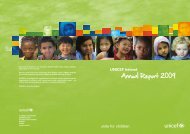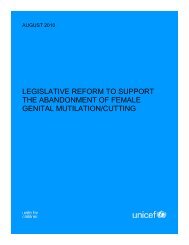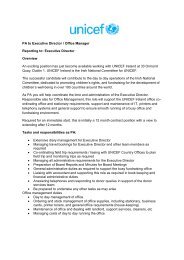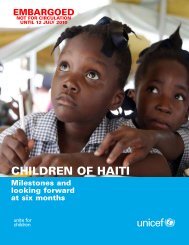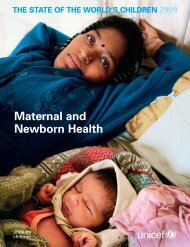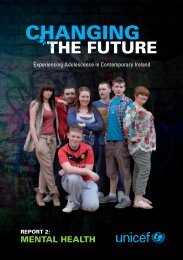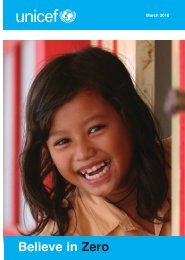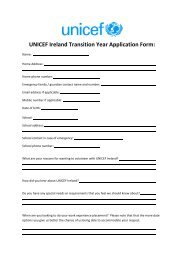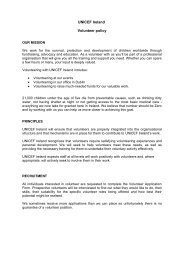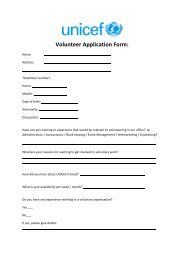Humanitarian Action for Children 2011 - Unicef
Humanitarian Action for Children 2011 - Unicef
Humanitarian Action for Children 2011 - Unicef
- No tags were found...
Create successful ePaper yourself
Turn your PDF publications into a flip-book with our unique Google optimized e-Paper software.
Democratic Republic of the Congo<strong>Children</strong> and women in crisisOngoing and newly emergent conflict and insecurity combined with chronic flooding, choleraand emergency-level malnutrition make the Democratic Republic of the Congo home to oneof the world’s worst and most protracted humanitarian emergencies. Since the late 1990s,waves of violent conflict have <strong>for</strong>ced hundreds of thousands of people from their homes; in late2010, the displaced population was an estimated 1.7 million, more than half of them children. 1Sexual violence continues at catastrophic proportions. <strong>Children</strong> and youths are routinely <strong>for</strong>cedinto armed groups against their will. Ongoing conflict in the east and northeast and dysfunctionalor non-existent infrastructure throughout the country make delivering humanitarian aidextremely challenging <strong>for</strong> reasons of security and physical access to communities in need.<strong>Humanitarian</strong>funding at work:Highlights from 2010In 2010, UNICEF estimated thatUS$122,500,000 was needed<strong>for</strong> its humanitarian work inthe Democratic Republic ofthe Congo. As of October2010, a total of US$54,647,298had been received, 45 percent of the goal. While fullfunding would have permittedhumanitarian assistance toreach a greater proportion ofthose in need, UNICEF wasable to improve the conditionsof children and womenaffected by emergencies ina number of ways. Theseincluded providing emergencyrelief kits to more than134,000 families and basicwater, hygiene and sanitationpackages to 588,800 people,and treatment <strong>for</strong> 2,500 peoplewith cholera. In addition,more than 55,000 children hadbetter access to education, and47,300 vulnerable or conflictedaffectedchildren participatedin child-friendly spaces.Meeting urgent needs and building resilience in <strong>2011</strong>UNICEF and its network of partners are leaders in both humanitarian response and coordinationin the Democratic Republic of the Congo. In <strong>2011</strong>, UNICEF will work with the Government,other UN agencies, and local and international NGOs as well as affected communities to meetthe needs of more than 4 million boys and girls and their families. As lead agency <strong>for</strong> thenutrition, education, WASH, emergency shelter and non-food items clusters and the childprotectionsub-cluster, UNICEF plays a central role in the planning, coordination, and provisionof technical guidance related to humanitarian response in the country.• UNICEF’s flagship Rapid Response to Movements of Population programme will reachmore than 1.7 million displaced persons, returnees and people from host communities withintegrated assistance in non-food item and shelter materials, emergency education, andbasic water, sanitation and hygiene assistance.• To save the lives of children who are severely undernourished, UNICEF will provide supplies<strong>for</strong> therapeutic feeding, including therapeutic food, equipment and drugs, and coordinateprogrammes to treat 122,000 children with severe acute malnutrition.• Some 1.5 million children under age 5 in conflict-affected areas will be vaccinated againstmeasles and receive deworming treatment and vitamin A supplementation.• More than 800,000, or an estimated 40 per cent, of the country’s displaced persons will gainaccess to adequate water and sanitation facilities; sanitation programmes in cholera-pronedisplaced and returnee communities will reach 140,000 people.• Emergency education programmes <strong>for</strong> 150,000 vulnerable and conflict-affected childrenand youths will offer them a sense of normalcy and protection. 70,000 of these children willreceive appropriate psychosocial support, with teachers and caregivers being given the toolsto support the emotional needs of children.• Around 50,000 displaced and returnee children will have access to the protectiveenvironment of child-friendly spaces; UNICEF will also assist in the separation andreintegration of 3,000 children <strong>for</strong>merly associated with armed groups and <strong>for</strong>ces andsupport the identification and reunification of 2,000 unaccompanied children.• Age- and gender-appropriate interventions will help 15,000 survivors of sexual and genderbasedviolence in conflict and displacement zones; 22,000 women who have experiencedsexual abuse and violence will receive medical treatment.Funding requirements <strong>for</strong> <strong>2011</strong>UNICEF is requesting US$115,290,000 to carry out its planned humanitarian activities in theDemocratic Republic of the Congo. This request is aligned with the <strong>2011</strong> <strong>Humanitarian</strong> <strong>Action</strong>Plan (HAP). Immediate and full funding is necessary to support the protection and recovery ofwomen and children.More in<strong>for</strong>mation on achievements of 2010 and the humanitarian action planned<strong>for</strong> the Democratic Republic of the Congo in <strong>2011</strong> can be found at www.unicef.org/hac<strong>2011</strong>.1. United Nations High Commissioner <strong>for</strong> Refugees, ‘Internally Displaced Persons (IDP) – Fact Sheet: DemocraticRepublic of Congo‘, UNHCR, Geneva, April 2010, p. 1.UNICEF EMERGENCY NEEDS FOR <strong>2011</strong> (in US dollars)Total $115,290,0007,000,000Health12,600,000Child protection3,264,000Clustercoordination33,000,000Emergency preparednessand response planning25,738,000 Nutrition15,123,000 WASH16,845,000Education1,720,000Shelter andnon-food items68 <strong>2011</strong> UNICEF <strong>Humanitarian</strong> <strong>Action</strong> FOR CHILDREN | www.unicef.org/hac<strong>2011</strong>DRC




